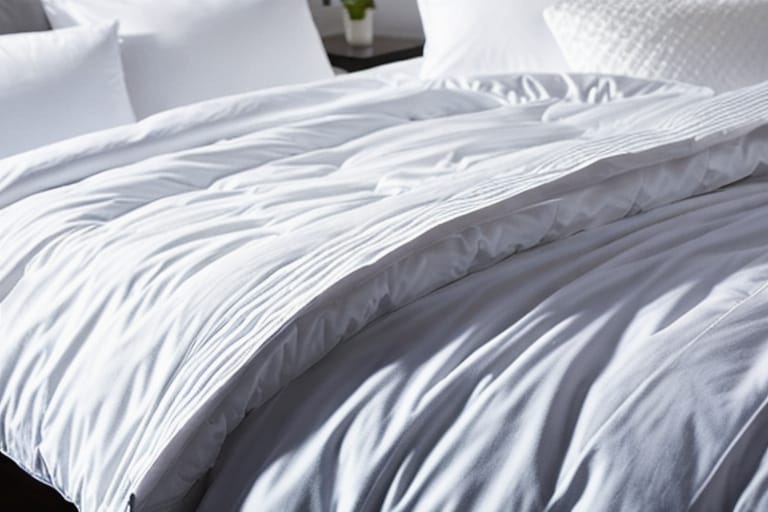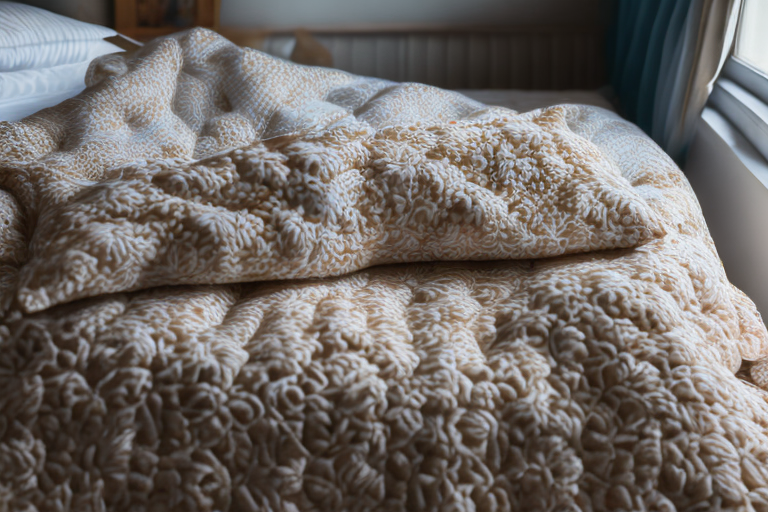Down duvets dominate the bedding market and they can make for incredibly warm, comfortable, and luxurious bed covers. But if you suffer from allergies, you may wonder if down duvets are really hypoallergenic and safe to use. This beginner’s guide answers all your questions about hypoallergenic properties, common misconceptions, and whether down bedding is suitable for allergy sufferers.
What Does Hypoallergenic Mean?
Hypoallergenic means something produces fewer allergic reactions. For bedding, this refers to materials less likely to cause issues for those with dust mite allergies or feather sensitivities. Hypoallergenic down duvets use special cleaning methods and barriers against dust mites.
Isn’t All Down Filling Allergenic?
It’s a common myth that all down and feathers trigger allergies. While some people have sensitivities, true allergies are rare. With proper processing methods, materials like Hungarian goose down can be hypoallergenic for most.
How Prevalent Are Down Allergies?
Out of all those with dust mite allergies, only around 0.7% showed reactions to feather tests. The flawless structure of down creates a smooth surface so even sensitive skin rarely reacts. With hypoallergenic treatments, down is allergy-free for almost everyone.
The Science Behind Hypoallergenic Down
Researchers have closely studied down’s hypoallergenic properties. Let’s review the science.
Research Findings from Wexner Medical Centre
A detailed feather and down allergy study at Ohio State University’s Wexner Medical Centre found the materials hypoallergenic for a majority of allergy sufferers. Participants showed little to no reaction.
Down vs. Synthetic Bedding
While materials like polyester and nylon resist dust mites, their loose weaves collect dander and proteins that provoke allergies. The tight clusters of down lack these allergenic structures so synthetics can actually be worse for allergy sufferers.
Improved Washing Processes
Advances in down cleaning methods like double rinsing, extended drying times, and biological detergents help remove residual allergens. This further reduces sensitivities and creates a hypoallergenic end product.
The Deal with Hungarian Goose Down
Goose down has an unrivaled softness. But is it suitable for those with allergies? Let’s explore Hungarian goose down specifically.
Facts About Hungarian Goose Down
- Sourced from geese in Hungary and Siberia
- Larger clusters than duck down
- Unparalleled thermal efficiency
- Softer and more resilient than other types of down
Down Proof Ticking and Certifications
- Products feature barrier fabrics blocking dust mites
- Certifications like Downpass Guaranteed indicate thorough analysis for allergens
- Multiple quality control checks ensure stringent standards
True Goose Feather Allergies Are Very Rare
- Geese lack the allergenic proteins present in duck feathers
- Smooth down clusters don’t impact those with sensitivities
- No scientific data shows goose down as an allergen
So properly sanitized Hungarian goose down presents almost zero risk to allergy sufferers. The hypoallergenic properties come from the down itself and the specialized cleaning processes.
Evaluating the Biological Safety of Down
To determine if down bedding poses allergy risks, manufacturers utilize tests like the integrative evaluation method.
The Integrative Safety Evaluation Method
This technique developed by Finnish researchers analyzes down samples across various hazard categories:
- Skin irritation
- Skin sensitization
- Eye irritation
- Respiratory sensitization
The well-rounded approach provides an accurate picture of down’s biological safety. Scientists synthesize data from clinical studies and conduct additional toxicity testing which products must pass to achieve hypoallergenic certification.
The Impact of Chemical Treatments
Certain processing methods involving bleach, acid baths, or fluorescent whitening agents create residual chemicals that worsen allergies. Reputable brands use biological detergents and techniques focusing on mechanical cleaning rather than harsh chemicals.
Results Confirm Hypoallergenic Properties
Both goose and duck down passed skin sensitization analyses. And across all evaluations, down showed no significant allergy risks or toxic effects. With stringent safety testing, brands confidently guarantee down bedding as hypoallergenic.
How Down and Down Alternative Compare
For allergy sufferers, a common question is whether to choose down or synthetic down alternative. Let’s stack them up.
Filling Types
- Down – Clusters of feather fibers, resilience varies by type of bird
- Down Alternative – Polyester fibers mimicking down clusters
Hypoallergenic Factors
- Down – Tight weave lacks allergens if properly cleaned
- Down Alternative – Loose chunks collect proteins triggering reactions
Breathability
- Down – Excellent moisture wicking and airflow
- Down Alternative – Synthetic materials retain heat and moisture
For temperature regulation and hypoallergenic properties, natural down is the best choice. The fluffy fibers allow excellent breathability. Just ensure proper cleaning protocols are followed.
Busting Myths About NOMITE Certification
Seeing NOMITE on bedding labels makes consumers feel it’s safe for allergies. But what does it really mean? Let’s explore common myths.
Myth: All NOMITE Items Are Allergy-Proof
- Fact: NOMITE guarantees protection against dust mites only, not feather allergies
- Confusion stems from dust mites worsening reactions in those with sensitivities
Myth: NOMITE Certification Is Extensively Regulated
- Fact: Brands self-declare products as NOMITE, no oversight exists
- This allows questionable allergy-proof claims without sufficient validation
Myth: NOMITE Equals a Total Allergen Barrier
- Fact: Barrier fabrics help but don’t fully block environmental allergens
- Other irritants can still enter interior through seams or micro-tears
NOMITE products feature barriers trapping dust mites. But they don’t guarantee complete allergen protection. Consumers should verify if more extensive hypoallergenic testing occurred before assuming bedding with this certification is suitable for their sensitivities.
Key Factors in Down Allergenicity
Aside from the down itself, certain factors like dust mites or chemical residues can influence allergenic reactions.
Dust Mites in Bedding
- Microscopic arachnids feeding on human skin cells
- Long-term bedding use allows large accumulations
- Allergic responses get worse over time
Harsh Chemical Treatments
- Bleaches, whiteners, and acid baths leave behind residues
- Contact with skin produces redness, swelling, and increased sensitization
- Those with multiple chemical sensitivities suffer most
Improper Care and Storage
- Failure to regularly clean bedding allows allergens to build up
- Humid storage environments enable dust mites to thrive
- Lack of maintenance shortens usable life span
Proper handling by manufacturers and consumers prevents allergen accumulation. Frequent washing also reduces irritants.
The Role of Processing for Hypoallergenic Down
A key factor making down suitable for allergy sufferers is the washing, drying, and sanitization methods utilized during manufacturing.
Multi-Rinse Washing Cycles
- Extended submersion and agitation
- Rinsing two to three times ensures removal of residual allergens
- Detergents lift dirt and flakes away from down clusters
Low Temperature Drying
- High heat damages down reducing benefits
- Biological drying uses low temperatures preserving properties
- Prevents musty odors from bacteria accumulation
Environmentally-Safe Detergents
- Biological ingredients break down allergens
- Avoids harsh bleach or chemical residues
- Certified non-toxic for consumer safety
Such methods yield sanitary, hypoallergenic down meeting the highest quality standards.
Identifying a True Down Allergy
Despite down’s rarity as an allergen, some consumers definitely experience feather sensitivities. But symptoms get mistaken for regular environmental allergies.
Common Signs of a Down Allergy
- Red, itchy bumps and hives where down bedding contacts skin
- Wheezing and difficulty breathing
- Runny nose, watery eyes, and other allergy-like symptoms
Seeking Professional Verification
- Allergists perform detailed skin prick and blood tests
- Patch tests with down samples help definitively diagnose feather allergies
Researching Brands and Manufacturers
- Learning about origin, washing methods, and certifications
- Identifying any chemical treatments used
- Reviewing all materials and barrier fabrics
This due diligence helps determine if reactions result from the down itself or some other factor. Consulting doctors and reading labels assists with making an informed decision when purchasing bedding.
The Synthetic vs Natural Bedding Debate

The bedding industry features an ongoing debate over materials. Should consumers choose synthetic down alternatives or natural products like feather and down? Both options have trade-offs.
Pros and Cons of Synthetic Bedding
Pros
- Resists dust mites due to smooth fibers
- Easy care since machine washable
- Lower cost than down
Cons
- Made from non-renewable petrochemicals
- Produces microplastics when washed
- Heat retention causes sweatiness
Pros and Cons of Natural Down
Pros
- Renewably sourced from fowl
- Biodegradable and eco-friendly
- Unmatched comfort and luxury
Cons
- Requires dry cleaning or specialized washing
- Premium cost over synthetics
- Supply chain issues like live-plucking
Neither choice is perfect. But natural down offers hypoallergenic properties and sustainability impossible to match with synthetics. Ethics and environmental factors deserve consideration too when purchasing bedding.
Maintaining Hypoallergenic Bedding Properly
To retain the non-allergenic qualities of down bedding, proper maintenance is crucial. This includes regular cleaning and ideal storage conditions.
Regular Machine Washing
- Check labels but wash down comforters every few months
- Use mild detergent and gentle cycle to prevent damage
- Dry thoroughly on low heat or air fluff setting
Barrier Layers Help
- Waterproof mattress pads prevent dust mite accumulation
- Duvet covers keep comforters clean between washes
- Pillow protectors stop skin oils and saliva from entering
Proper Storage Tips
- Store in breathable cotton cases allowing airflow
- Avoid plastic containers trapping humidity
- Freezing for 24 hours kills any dust mites
With some basic maintenance, consumers can keep bedding like down comforters fresh and hypoallergenic for years of quality sleep.
Sourcing Down Responsibly
Another key consideration is the ethical treatment of geese and ducks providing feathers. Conscientious companies utilize responsible harvesting practices and humane protocols.
Oversight Organizations
- Responsible Down Standard (RDS) – Audits and certifies the supply chain to ensure humane treatment of animals
- Textile Exchange – Promotes sustainability with strict protocols like the Responsible Down Standard across the industry
- Global Traceable Down Standard – Provides consumer assurance that materials do not come from unethical sources
What Consumers Can Do
- Seek bedding with certifications like RDS or Global Traceable Down
- Support brands aligned with oversight organizations
- Write companies requesting increased transparency in down sourcing
Vote with your wallet by purchasing bedding demonstrating environmental consciousness and ethical animal husbandry.
Temperature, Humidity, and Allergies

Aside from barriers and cleaning methods, another way down bedding minimizes allergens is by regulating temperature and humidity.
How Down Regulates Climate
- Absorbs excess moisture decreasing humidity
- Provides insulation stabilizing temperatures
- Airflow through plush filling circulates heat and gases
Effects on Dust Mite Populations
- Lower humidity levels prohibit reproduction
- Most species thrive in humid environments like mattresses
- Maintaining climate equilibrium keeps numbers down
So aside from barrier fabrics, down’s breathability creates an inhospitable environment for allergens like dust mites. The filling’s lofty structure and moisture wicking assist with preventing allergy triggers.
Allergy-Friendly Options and Best Buys
When purchasing bedding, look for brands specializing in hypoallergenic lines. Let’s review top options providing a peaceful night’s sleep for allergy sufferers.
| Brand | Product | Price |
|---|---|---|
| White Goose Down | Deluxe Hungarian Goose Down Comforter | $359+ |
| Beyond Down | Premium Downproof Box-Stitch Comforter | $256+ |
| Italian Luxury | 800 Fill Power RDS Certified Goose Down Pillows (Set of 2) | $169+ |
| Sleep Philosophy | 350 GSM 100% Cotton Sateen Duvet Cover Set | $114+ |
| Puredown | Feather-Free Synthetic Bedding Comforter | $90+ |
| Rest Luxury | Premium Cotton Mattress Pad Protector | $59+ |
| Dust Mite Solutions | Waterproof Pillow Protectors (Set of 4) | $29+ |
With options across budgets, everyone can sleep comfortably. Seek out materials meeting allergy avoidance standards and utilize protective layers too.
Common Down Allergy Myths
Despite evidence of down’s hypoallergenic properties, misconceptions about allergies and feathers still abound. Let’s clear up some popular myths.
True or False? Duck Feathers Cause More Reactions than Goose
Verdict: True
Duck feathers feature higher counts of IgY antibodies provoking skin and respiratory reactions. Goose down lacks these antigens so causes fewer issues.
True or False? Feathers Contain More Allergens than Down
Verdict: True
The quill of feathers includes proteins and dander triggering allergies. Down’s fluffier structure smooths over sensitivities. Proper washing eliminates irritants.
True or False? All Barrier Fabric Means 100% Allergen Protection
Verdict: False
Although materials like cotton, polyester, eucalyptus, and silk protect against dust mites, they don’t block other environmental allergens. No product prevents all possible reactions.
Always scrutinize “hypoallergenic” marketing claims before purchasing bedding. Assess your specific sensitivities and seek evidence supporting allergy-free declarations. Don’t assume barrier fabrics or even NOMITE certification guarantees zero reactions.
The Takeaway: Make an Informed Decision
This guide presented the science confirming down bedding’s hypoallergenic properties for a majority of consumers. But those highly sensitive to feathers should opt for synthetic alternatives and enhanced allergen blocking layers.
When sourced ethically and cleaned through biological methods, materials like Hungarian goose down provide unrivaled comfort perfect for those seeking luxury and breathability. Brand transparency builds trust in supply chains. And proper maintenance retains hypoallergenic characteristics over years of use.
Hopefully the research compiled here empowers consumers to make informed bedding purchases aligned with both allergy needs and ethical values. Sweet dreams!
Frequently Asked Questions
Is goose down still hypoallergenic if not washed properly?
No. If goose down hasn’t undergone thorough washing protocols including multiple rinses, extended drying times, and the use of biological detergents, it may still contain proteins and residues that can trigger allergic reactions in sensitive individuals. Always check the processing methods before assuming down bedding is completely hypoallergenic.
Do Hungarian goose down duvets offer better temperature regulation than other types of down?
Yes. The large, fluffy clusters of Hungarian goose down have superior breathability and moisture wicking abilities. This effective airflow and climate control within the filling creates an environment unfavorable to dust mites. So Hungarian goose down excels at keeping sleepers comfortable while also inhibiting allergens.
Does NOMITE certification on bedding guarantee it’s 100% allergen proof?
No. NOMITE mainly indicates the use of barrier fabrics that prevent dust mites, but other environmental proteins can still enter the interior down through seams or microscopic tears. NOMITE products feature construction methods limiting allergen exposure, but no bedding offers complete impenetrability to irritants. Those highly sensitive should take care.
What filling type, down or down alternative, rates better for allergy sufferers?
Down filling rates as the superior choice for allergy sufferers when properly washed. The tight weave resists collection of skin proteins and the smooth exterior fails to adhere allergens like dander. By contrast, the loose chunks of down alternative trap irritants. As long as effective cleaning protocols remove antigens, real down works better than synthetic in terms of hypoallergenic properties.
Is it true goose down rarely causes allergies in consumers?
Yes, that statement rates as true. Extensive allergy testing on goose down samples by research bodies has shown very few allergenic reactions related to the material itself. The smooth molecular structure lacks reactive antigens. And when effective washing techniques eliminate residual proteins introduced by handling and processing, goose down ranks as highly hypoallergenic, causing few issues even for sensitive individuals.
Do Hungarian goose down clusters or Siberian goose down have superior resilience and durability?
Hungarian goose down rates as superior in terms of durability and maintaining loft over years of use. The large, fluffy clusters exceed Siberian goose down in resilience. Products utilizing Hungarian down maintain their fluffiness and insulation capabilities longer than those with Siberian down. When seeking bedding providing many years of comfort, Hungarian down represents the best buy.
Is dry cleaning or machine washing more effective for cleaning down bedding?
Machine washing rates as more effective for sanitization and removing allergens from down bedding as long as manufacturers’ guidelines get followed. Home washing with biological detergents lifts away oils and proteins when brands prescribe the proper cycles, water temperatures and drying methods for their products. The mechanical process surpasses solvent-based dry cleaning. Check labels before cleaning down bedding and pillows. Proper technique preserves benefits.








